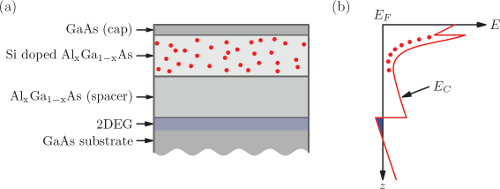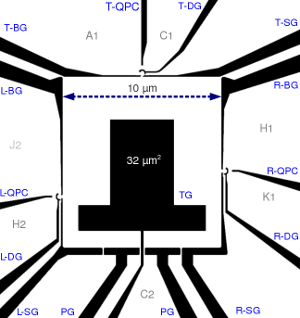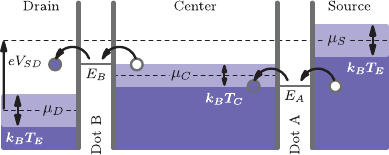The project involves the fabrication and measurement of a quantum-dot-based device defined by Au gates lithographically patterned on the surface of aGaAs/AlGaAs hetero-structure. These gates constrain the two-dimensional electron gas at the GaAs/AlGaAs interface, to form either 2-D electron reservoirs (described by a Fermi Dirac distribution), 1-D quantum wires (in which the electron momentum is quantised in one direction), or 0-D quantum dots (in which an electron is completely confined).
 Fig 1: (a) This is a cross-section of a high electron mobility heterostructure (HEMT). An n-doped layer of AlGaAs provides the excess electrons which are trapped in the potential well at the GaAs/AlGaAs interface, thus forming a two dimensional electron gas (2DEG). (b) This is the corressponding band edge probile. The red dots depict the randomly positioned Si dopants. E is the energy scale in the z direction, EF is the Fermi level, and EC is the energy of electrons in the conduction band. The purple region shows the electrons trapped in the potential well at the hetero-junction. [*]
Fig 1: (a) This is a cross-section of a high electron mobility heterostructure (HEMT). An n-doped layer of AlGaAs provides the excess electrons which are trapped in the potential well at the GaAs/AlGaAs interface, thus forming a two dimensional electron gas (2DEG). (b) This is the corressponding band edge probile. The red dots depict the randomly positioned Si dopants. E is the energy scale in the z direction, EF is the Fermi level, and EC is the energy of electrons in the conduction band. The purple region shows the electrons trapped in the potential well at the hetero-junction. [*]
 Fig 2:Electron beam gates of the QDR. Each quantum dot is defined by three gates: a barrier gate (BG), a square gate (SG), and a dot gate (DG). Each dot is associated with a 1D detector which is defined by a quantum point contact gate (QPC). The large top gate (TG) increases the capacitance of the central square region, which is 100μm2 in area. The two pinch-off gates (PG) help define the central region. The contacts marked in grey are the ohmics.
Fig 2:Electron beam gates of the QDR. Each quantum dot is defined by three gates: a barrier gate (BG), a square gate (SG), and a dot gate (DG). Each dot is associated with a 1D detector which is defined by a quantum point contact gate (QPC). The large top gate (TG) increases the capacitance of the central square region, which is 100μm2 in area. The two pinch-off gates (PG) help define the central region. The contacts marked in grey are the ohmics.
In particular, we are working on the design and development of a quantum-dot refrigerator (QDR), in which the metal gates define three quantum dots (left, right, and top) tunnel coupled to an enclosed, macroscopic, two-dimensional reservoir of electrons. A QDR utilises the energy-selective transport of electrons through the left and right quantum dots to customise the Fermi-Dirac distribution of the macroscopic two dimensional electron reservoir. The transport of one electron removes an amount of energy equal to the difference between the two dot energies from the reservoir, effectively cooling it. A third quantum dot tunnel coupled to the reservoir can characterise the Fermi Dirac distribution of the cooled region, and thus measure its temperature.
 Fig 3: Energy levels of a Quantum Dot Refrigerator. Occupied states in the `Source', `Centre' and `Drain' 2DEGs are shown by the blue shaded areas, and the light blue shading around their respective Fermi energies (μS, μC,and μD) indicates their thermal broadening. Dots A and B both have a single particle state available for transport in the energy range shown, with electrochemical potentials of μA and μB respectively. The net transfer of an electron from source to drain removes and energy (μA - μB) from the central region. in the cooling regime. [*]
Fig 3: Energy levels of a Quantum Dot Refrigerator. Occupied states in the `Source', `Centre' and `Drain' 2DEGs are shown by the blue shaded areas, and the light blue shading around their respective Fermi energies (μS, μC,and μD) indicates their thermal broadening. Dots A and B both have a single particle state available for transport in the energy range shown, with electrochemical potentials of μA and μB respectively. The net transfer of an electron from source to drain removes and energy (μA - μB) from the central region. in the cooling regime. [*]
We have obtained preliminary cooling results, and have also implemented a novel non-invasive method of measuring the temperature of the cooled electrons by means of the third `thermometer' dot. My future aims are to substantially cool the reservoir (to below the ambinet lattice temperature), and to investigate the limits of the thermometry scheme.
The two-dimensional electron gas in GaAs/AlGaAs heterostructures has diverse applications at cryogenic temperatures, but is elevated to higher temperatures than the ambient lattice temperature because of reduced phonon coupling. Therefore, a mechanism which can efficiently cool the electron gas to below the lattice temperature can have a far reaching impact on the performance of heterostructure devices, and can provide a window to new physics by making lower temperature regimes accessible. In addition to this, the QDR is also capable of measuring out-of-equilibrium Fermi-Dirac distributions of the electron gas. The end goal of a successful refrigeration scheme will be to use the cooled reservoir of electrons to electronically cool a coupled quantum device.
See here for a popular write-up of this work.
* Adapted from "Cooling an electron gas using quantum dot based electronic refrigeration" PhD Thesis, Prance J.R.
References:
“A non-invasive electron thermometer based on charge sensing of a quantum dot ”
A. Mavalankar, S. J. Chorley, J. Griffiths, G. A. C. Jones, I. Farrer, D. A. Ritchie, and C. G. Smith,
2013, Appl. Phys. Lett., 103, 133116.
“Electronic refrigeration of a two-dimensional electron gas”
Prance J. R., Smith C. G., Griffiths J. P., Chorley S. J., Anderson D., Jones G. A. C., Farrer I. and Ritchie D. A.,
2009, Phys. Rev. Lett., 102, 146602.
